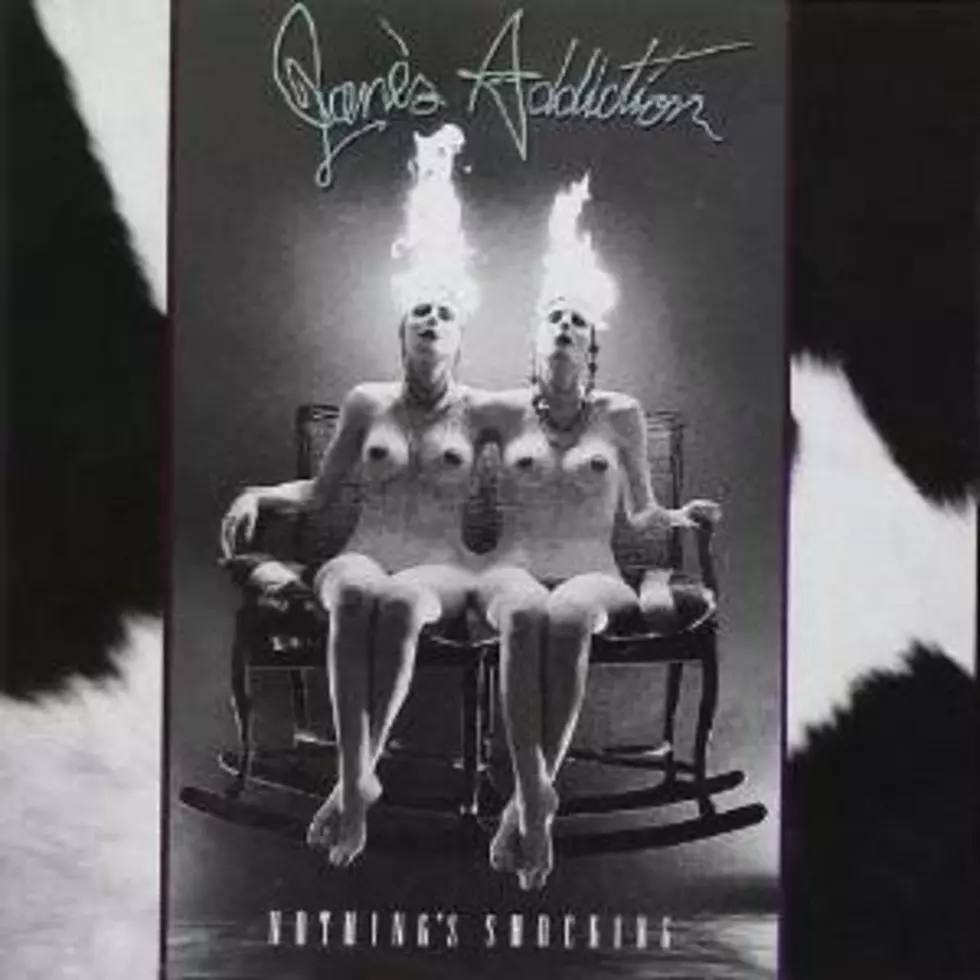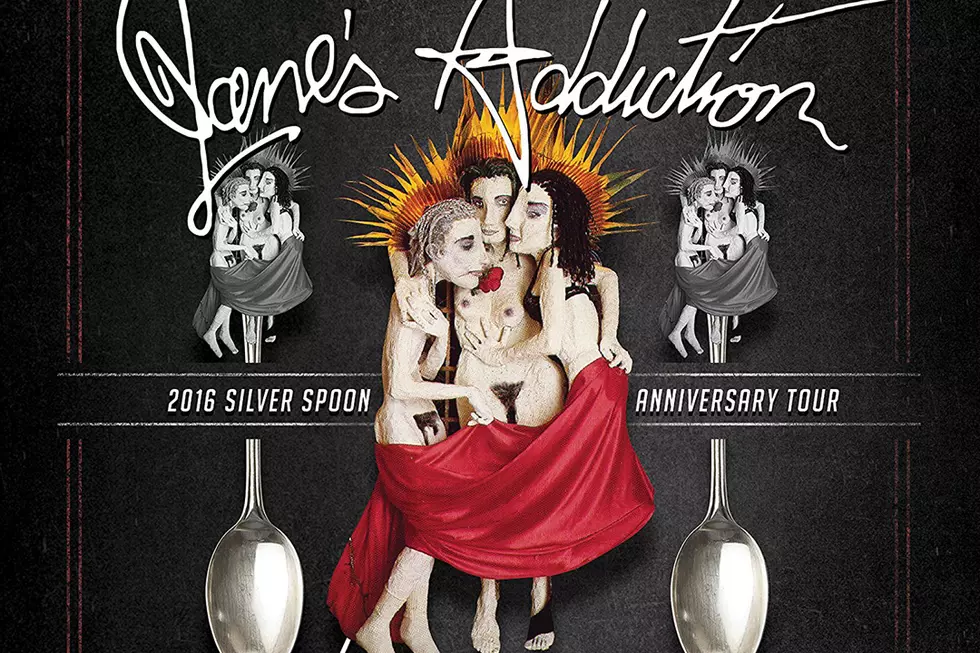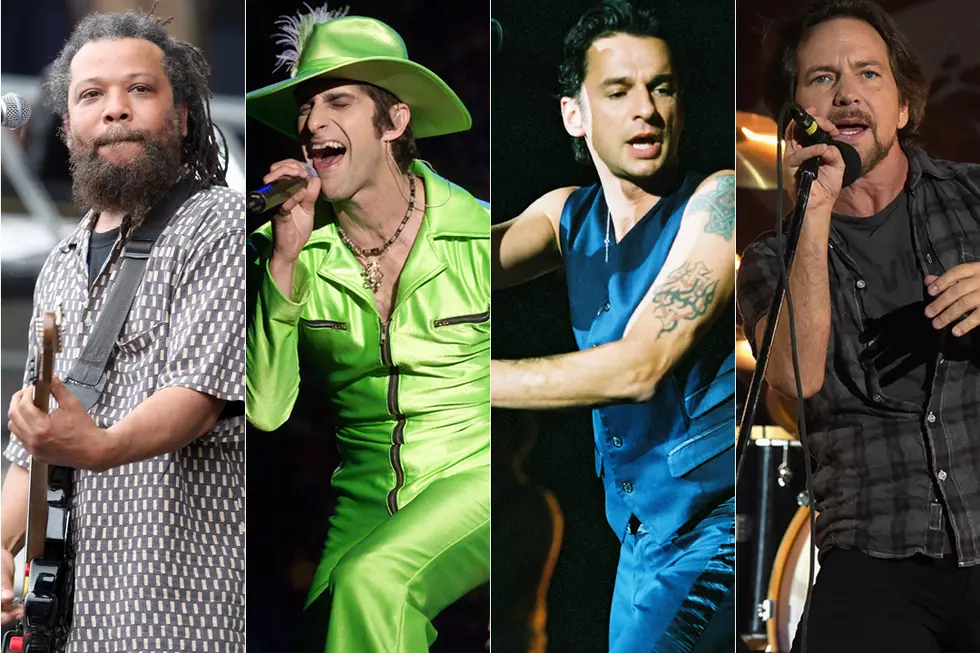
The Roots of Indie: Jane’s Addiction – ‘Nothing’s Shocking’
Take a seat in that rocking chair over there, youngster, and I'll tell you a tale from the old days. If those flaming conjoined twins are in your way, just push them to the floor.
Way back in 1900 and 85 these strange beasts roamed the Earth called shredders. They were easy to spot, thanks to their leopard print tights, big hair and excessive eyeliner, but what really distinguished shredders from all other life forms was their affinity for playing guitar at blistering speeds.
Shredders and their bands roamed Los Angeles, their high heels clicking on the sparkly pavement while girls in acid washed jeans followed behind. They played clubs with names like the Cathouse, Gazarri's and the Roxy, and adoring fans swooned while the shredders went meedly-meedly-meedly on their polka dotted guitars and the singers wailed about parties and girls.
There was another world in Hollywood, too -- the punks and runaways and goths who found their way to Los Angeles in the wake of the great post-punk bubble of the late '70s and early '80s. They weren't welcome in the glittery clubs lining the Sunset Strip, but that doesn't mean they weren't welcome anywhere. Just like in their home towns, they gathered in underground clubs to listen to their music: smart, emotional, artsy. Their songs weren't concerned with parties and girls, at least not exclusively. The underground clubs were bubbling cauldrons of krautrock, punk, new wave and noise.
And so it was that in 1985 two legendary bands formed, Guns N' Roses and Jane's Addiction. One became the biggest band on the Strip, the other the biggest band in the underground. Within two years both would sign huge deals, release pseudo-debut records on independent labels, and then come out swinging with phenomenal major label debuts.
There were other similarities. Both bands featured charismatic front men who could hypnotize any crowd, for example, but perhaps more importantly both bands featured shredders. During that period, there was a very distinct line separating metal and alternative. Indie music (or "college radio" as we called it back then) didn't feature guys who could play 16 notes per second on their Charvel guitars, and Sunset Strip bands didn't include guys with Rickenbackers and mandolins. It's just the way things were.
That was the distinct genius of Jane's Addiction. Formed by front man Perry Ferrell and bassist Eric Avery, the two recruited drummer Stephen Perkins into the fold. Perkins recommended his teenaged buddy, Dave Navarro, for the guitar chair. Navarro already had a reputation around L.A. as a gunslinger, and by all accounts he should've donned the tights and Aqua Net and headed for the Strip. He didn't -- he joined Jane's, and the result was like nothing else at the time: art school smart meets Sunset Strip attitude.
Attention was focused on the band's enigmatic singer and Navarro's guitar histrionics from the beginning, but it's bassist Avery's simple bass figures that define the bulk of Nothing Shocking's 11 tracks. Consider album opener "Up the Beach," which opens with Avery's bass rolling in like a distant wave before the whole thing crashes to shore:
Ferrell sings one single word during that opening track: "Home," and that's exactly how many of us felt.
Not that he remained silent for long. The beach motif continued into track two, "Ocean Size," where the singer roars, "Wish I was ocean sized / They cannot move you, man, no one tries" and "I want to be more like the ocean / No talk and then all action." Ferrell's lyrics were both powerful and evocative, and he knew it. The frontman demanded the lion's share of the publishing royalties, even though all four band members contributed significantly to the actual music. His demands were met, but as is often the case, the publishing battle did irreparable harm to the band.
"Mountain Song" was released as a single in advance of the album. In truth the cut had already been floating around for a couple of years thanks to its inclusion on the Dudes soundtrack, where Jane's Addiction were featured alongside headbangers like Megadeth and Keel.
The video, shot at their home club Scream, is a pretty good approximation of what a Jane's show was like:
If Nothing's Shocking did nothing but hammer listeners over the head with noodling guitars, it wouldn't have been shocking. For that matter, if the band included a lighter waving power ballad no one would have been surprised. Jane's painted with a much broader palette, inviting friends Flea (Red Hot Chili Peppers) and Angelo Moore (Fishbone) to play horns on "Idiot's Rule," breaking out the steel drum for their best known song, "Jane Says," and slowing the tempo for the hippie gentleness of "Summertime Rolls."
Drugs and power struggles did the band in after their follow-up album, Ritual de lo Habitual. During the tour supporting that album, Ferrell revived the dormant (in America, at least) notion of the music festival, sending Jane's off in style with the inaugural Lollapalooza. That festival did more to grow alternative music than anything other than perhaps Nirvana, but that's a story for another time.
I have no evidence of this, but having lived through it I don't think that grunge could have penetrated the shield of hairspray that surrounded the Strip if Jane's Addiction hadn't paved the way. By welding underground attitude to hotshot guitar, the band made it okay for art school kids to like both Nothing's Shocking and Appetite for Destruction, just like the band's friends in the Red Hot Chili Peppers broke down the wall between alternative and funk.
Jane's Addiction reunited quite a few times, and the band minus Eric Avery still tours and makes music. They're still amazing, too. What's that? You want to hear that song again? Well, okay, but bust out your lighters.
More From Diffuser.fm









